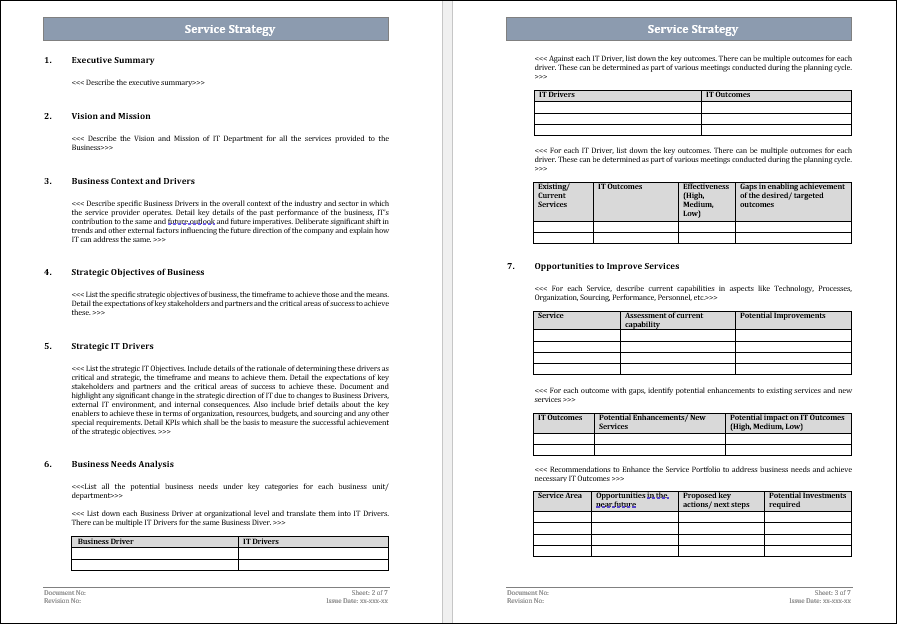Service Strategy Template
Introduction
A Service Strategy Template in IT Governance is a structured framework that outlines an organization's overarching plan and goals for delivering and managing information technology services. Key components include defining service offerings, identifying target customers, establishing service levels, and integrating IT activities with business goals. This template establishes a framework for decision-making, resource allocation, and performance measurement to ensure that IT services effectively contribute to the overall business plan. It frequently includes sections on service design, financial management, demand management, and other critical elements, yielding a holistic roadmap for improving IT service delivery and value creation.

Scope Of Service Strategy Template
The Service Strategy Template is critical in IT Governance because it provides a thorough path for aligning IT activities with overall business objectives. By offering a formal framework for establishing and managing IT services, the template guarantees that technology endeavours are strategically aligned, increasing their contribution to the organization's overall success. It enables IT leaders to take a proactive approach to decision-making, prioritising efforts that directly support business objectives. This alignment not only improves the efficiency of IT service delivery but also increases the organization's resilience and agility to changing market conditions.
Monitoring and Controlling The Service Strategy Template
Monitoring:
1. Key Performance Indicators (KPIs):
- Define particular metrics that correspond to the goals mentioned in the service plan.
- Customer satisfaction scores, service delivery times, and revenue growth are all possible examples.
2. Data Collection and Analysis:
- Create a systematic strategy for gathering important data.
- Use tools and strategies to analyse acquired data and gain insights into performance.
3. Reporting Mechanism:
- Determine how performance data will be communicated throughout the organisation.
- Determine the frequency of reports and the format in which they will be given.
4. Performance Reviews:
- Schedule regular performance reviews to determine how successfully the service strategy is being implemented.
- Involve important stakeholders in these reviews to acquire a diversified perspective.
5. Feedback Loops:
- Implement procedures for collecting feedback from customers and internal stakeholders.
- Use the comments to find areas for improvement and validate the strategy's efficacy.
Controlling:
1. Adjustments and Adaptations:
- Establish criteria for making changes to the service strategy.
- Determine how feedback and performance data will guide any necessary modifications to the approach.
2. Escalation Procedures:
- Define methods for dealing with issues that may arise during the strategy's implementation.
- Identify the accountable parties and provide clear communication routes for problem resolution.
3. Continuous Improvement:
- Emphasise your commitment to ongoing improvement based on performance insights.
- Encourage a proactive approach to modifying the strategy as circumstances change.
4. Learning from Data:
- Highlight the importance of data in finding areas for improvement.
- Encourage the organisation to have a learning culture and make data-driven decisions.
5. Adaptation and Innovation:
- Highlight the relevance of modifying the service approach to changing client needs and market trends.
- Encourage new solutions that improve overall service delivery.

Benefits Of Service Strategy Template
- Alignment with Business Goals: Ensures that IT services align with the broader business strategy, promoting synergy between technological projects and organisational goals.
- Resource Optimization: Prioritises and plans IT services based on business priorities, allowing for more efficient use of resources such as budget, manpower, and technology.
- Improved Decision-Making: Provides a systematic framework for decision-making, enabling IT leaders to make educated decisions that are consistent with the organization's strategic direction.
- Enhanced Service Quality: Encourages the creation of explicit service definitions, standards, and service level agreements, resulting in higher service quality and customer satisfaction.
- Financial Management: Facilitates successful financial management by outlining budget allocations, cost structures, and funding models, allowing organisations to optimise costs and allocate resources wisely.
- Risk Mitigation: Identifies and manages possible hazards connected with IT services, enabling organisations to proactively deploy mitigation methods and improve overall risk management.
Conclusion
The Service Strategy Template is a key component of IT Governance, providing organisations with a methodical and strategic approach to managing IT services. The template guarantees that IT is a key enabler of organisational performance by connecting technological activities with overarching business goals. Its function in resource optimisation is critical, allowing for the careful allocation of financial, human, and technological resources to prioritise efforts that directly contribute to business objectives.


